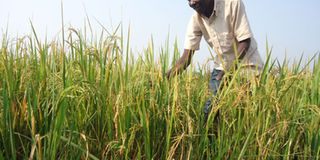African countries focus on boosting rice production, Uganda to host conference

A rice farmer gathers a harvest from his field. While rice is an increasingly a staple food, the production is yet to meet the demand. FILE PHOTO
Several ministers of agriculture from Africa will meet in Kampala early February to discuss rice research and development, production and policy.
The meeting, known as “the 30th Extra-Ordinary Session of the AfricaRice Council of Ministers,” will appoint a new Director General for AfricaRice Centre.
The meeting will be held February 6-8 and more than 50 dignitaries are expected to attend. Of these, 25 will be ministers of Agriculture or their representatives.
“It will be very important for the continent because AfricaRice is a pan-African intergovernmental research that oversees research and development of rice, which is now a priority crop,” said Dr Jimmy Lamo, Principal Research Officer, National Crops Resources Research Institute (NaCRRI), Namulonge. He is on the national organising committee.
There over 25 member states of the AfricaRice Council. Currently, Dr Adam Traore from Mali is the interim Director-General, while Uganda’s minister of Agriculture, Tress Bucyanayandi, is the chair of the Council of Ministers.
Sierra Leonean, Dr Harold Roy-Macaulay, was nominated by the Board of Trustees for the position of director general.
The Board of Trustees nominated him at its meeting held in Cotonou, Benin, in September 2014.
At the continental level, rice constitutes a major part of the diet. During the last three decades, rice has seen consistent increases in demand.
Its growing importance is evident in the strategic food security planning policies of many countries, according to the International Rice Commission (IRC).
With the exception of a few countries that have attained self-sufficiency in rice production, rice demand exceeds production.
Large quantities are imported to meet demand at a huge cost.
“Africa consumes a total of 11.6 million tonnes of milled rice per year, of which 3.3 million tonnes are imported. As many as 21 of the 39 rice-producing countries in Africa import between 50 and 99 per cent of their rice requirements,” states the IRC.
The distribution of rice imports on a regional basis appears skewed.
North and Central Africa regions set the lower limits at 1.7 per cent) and upper limits at 71.7 per cent, respectively.
It adds: “Africa’s inability to reach self-sufficiency in rice is the result of several major constraints in the rice industry which require urgent redress to stem the trend of over-reliance on imports and to satisfy the increasing demand for rice in areas where the potential of local production resources is exploited at very low levels.”
Member-states of AfricaRice Council of Ministers include Benin, Burkina Faso, Cameroun, Central African Republic, Chad, Congo, Cote d’Ivoire, DR Congo, Gabon, Gambia, Guinea, Guinea-Bissau, Madagascar, Mali and Mauritania.
Others are: Senegal, Togo, Nigeria, Liberia, Ghana, Sierra Leone, Egypt, Rwanda and Uganda.
Rice production and consumption
Africa produces an average of 14.6 million tonnes of rice per year on 7.3 million hectares, which is equivalent to 2.6 and 4.6 per cent of the world’s total production and area under rice, respectively. West Africa has the largest area planted with rice in Africa (56.5 per cent), that is about 3.7 million hectares.
The area increased steadily between 1989-1996 by a total increase of 900,000 hectares. West Africa had the greatest increase while the four other regions showed only insignificant changes.
The regional contributions to rice production are: West Africa (42 per cent), North Africa (32 per cent); East Africa (23.8 per cent), Central Africa (1.2 per cent); and Southern Africa (1 per cent).
The average grain yield (2.1 kilogrammes per hectare) is 49 per cent below the world average (3.4 kilogrammes per hectare). This low grain yield is caused by several factors, including the low levels of production technologies and the dominance of the upland ecology in Africa.
Only 11 per cent of the rice area is irrigated compared with 53 per cent worldwide. The average grain yield in Africa shows very little improvement over time.
Consumption
Africa consumes 11.5 million tonnes of rice per year, 33.6 per cent of which is imported. The import trends showed only a small decline of 55,000 tonnes, while paddy production increased by 2.3 million tonnes.
The decline in imports could be attributed mainly to East Africa. But West Africa’s rice self-sufficiency levels are the highest in Africa.
The average self-sufficiency levels for West African countries showed a steady decline from 1960 to 1996 (that is, from 72.2 per cent to 46.6 per cent), an indication of the region’s inability to meet increasing demand through local production.
The average self-sufficiency of Central Africa reached 37.9 per cent, East Africa at 58.3 percent, and Southern Africa at 42.5 percent.
Nigeria, which is Africa’s largest rice producer, plans to raise production to 300,000 metric tonnes a year. This will reduce its imports by 15 per cent and cut costs by $342m a year.
But it is also the world’s largest importer of rice at 2.3 million tonnes a year. Current total consumption is 4.9 million tonnes. Estimates are that the demand in the country will be 35 million tons by 2050.
But it could produce enough grain in four years to cover its needs, which would allow it to export to other West African countries and compete with Thailand and India.
In Uganda, rice has become the most popular staple food. Rice production increased from 120,000 metric tonnes in 2002 to 200,000 in 2010. This saves the country about Shs120b ($50m) annually in rice imports.
According to data by the ministry of Agriculture, Uganda exports 40,000 to 50,000 metric tonnes of rice to South Sudan, DR Congo, Kenya and some Middle East countries.
Meanwhile, in North Africa, Egypt produces enough to meet local demand and exports the surplus, but its export market has declined because of increased local consumption.
However, Egypt has complete self-sufficiency in rice (99.99 per cent), while Eastern African rice self-sufficiency is as follows: Burundi (83.1 per cent), Kenya (41 per cent), Madagascar (96.6 per cent), Mozambique (98.8 per cent), Tanzania (84.9 per cent), Rwanda (34.2 per cent), and Uganda (91.6 per cent)
-Source: International Rice Commission




